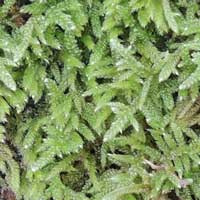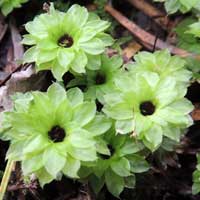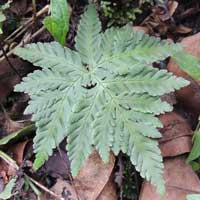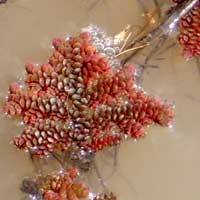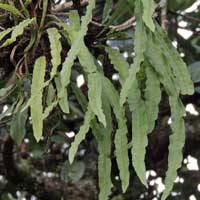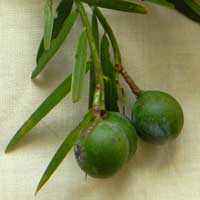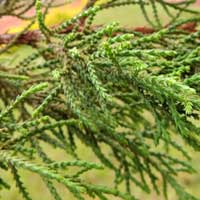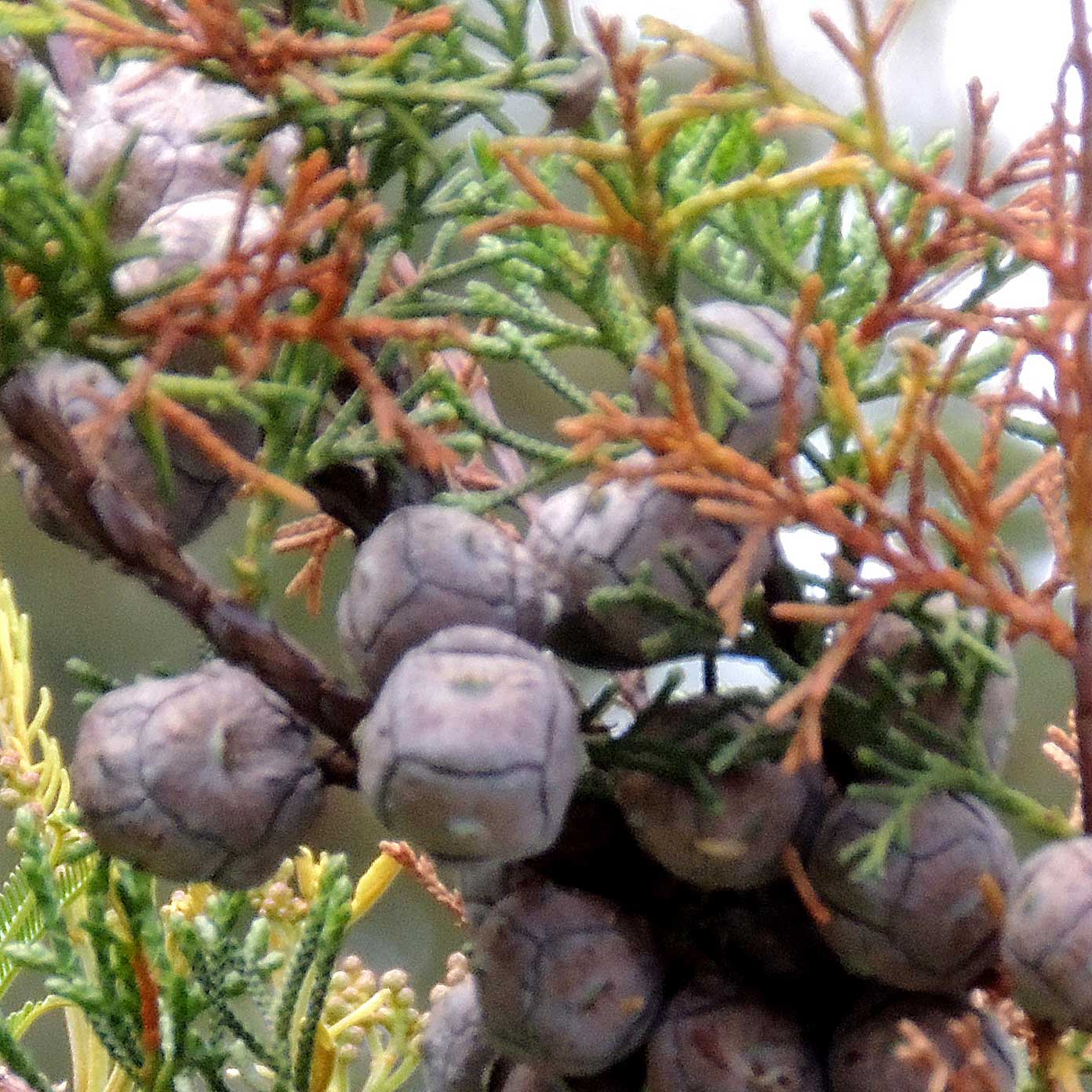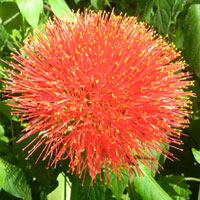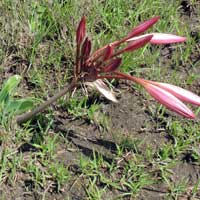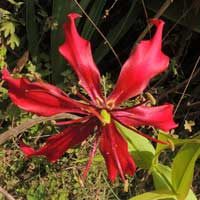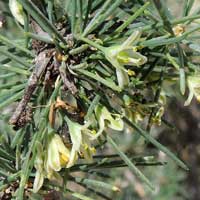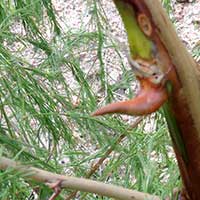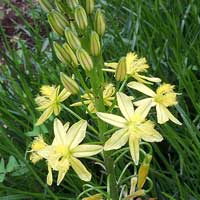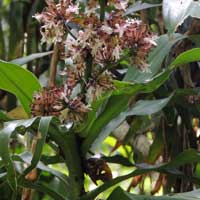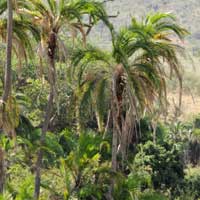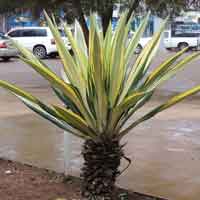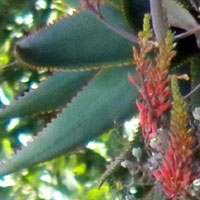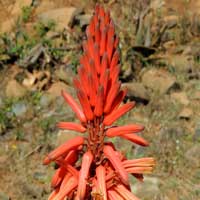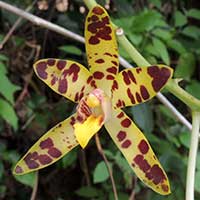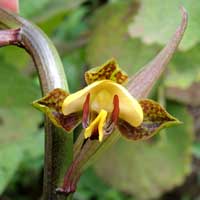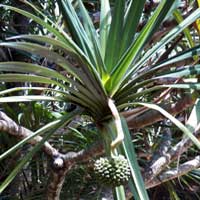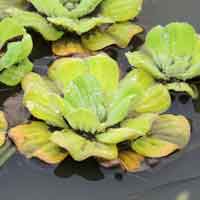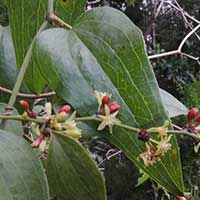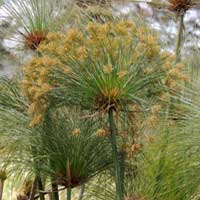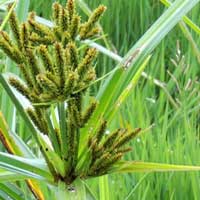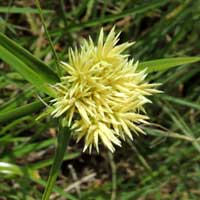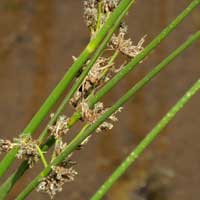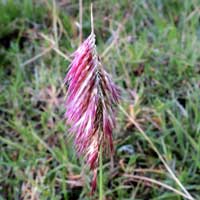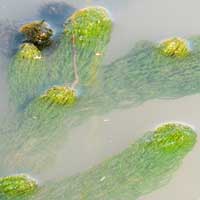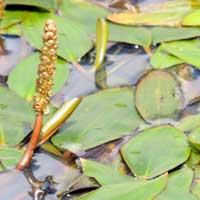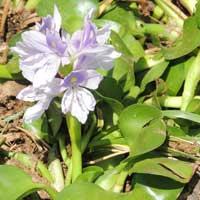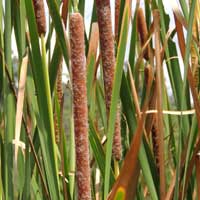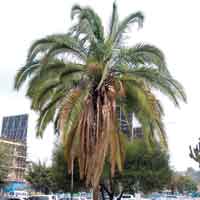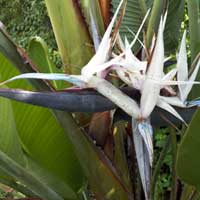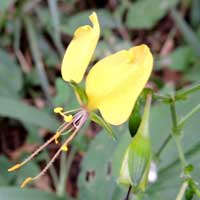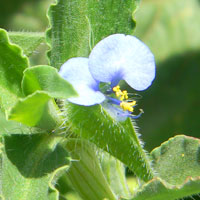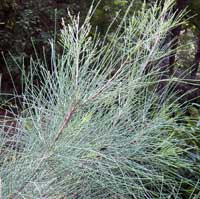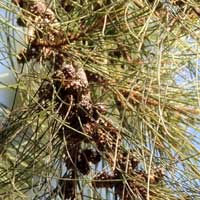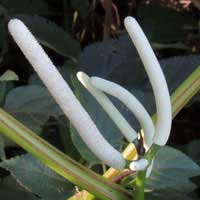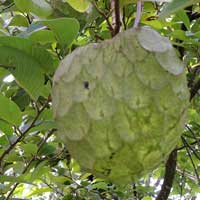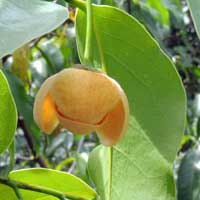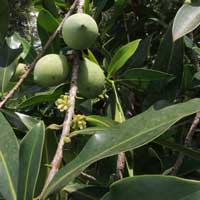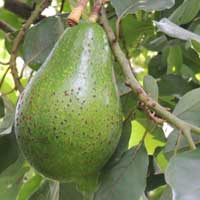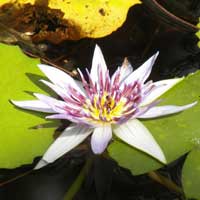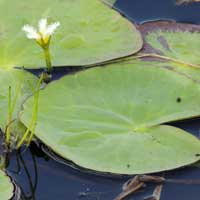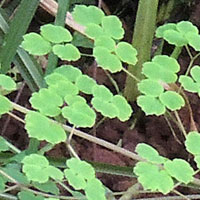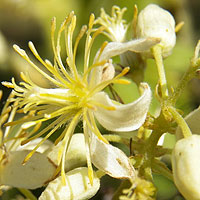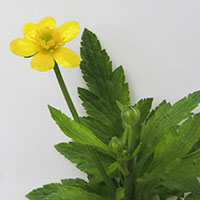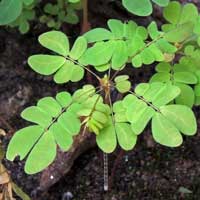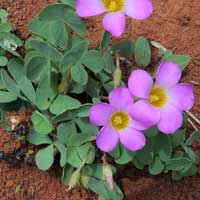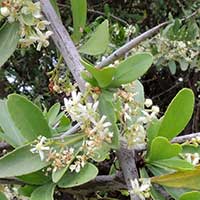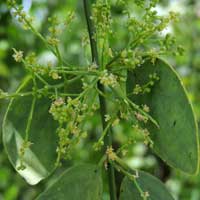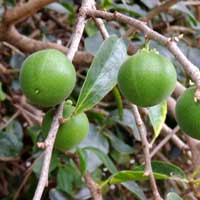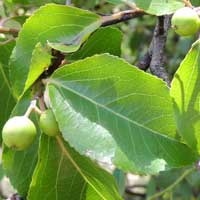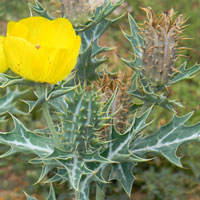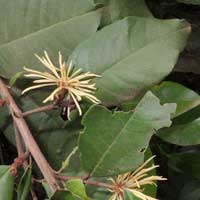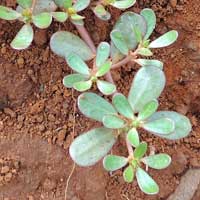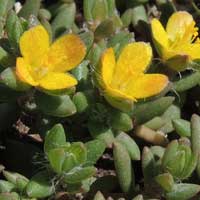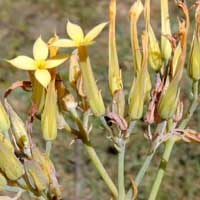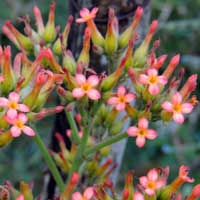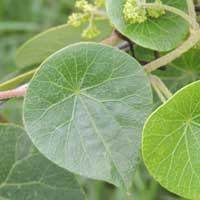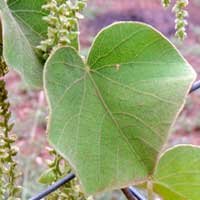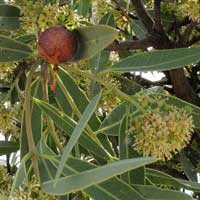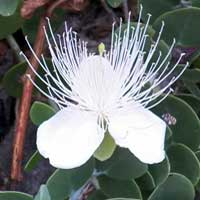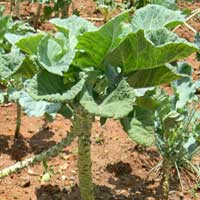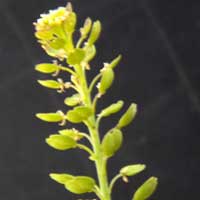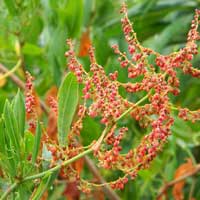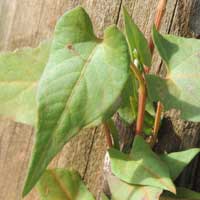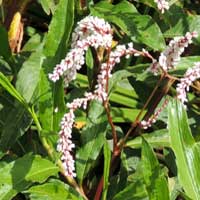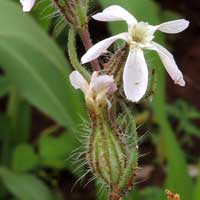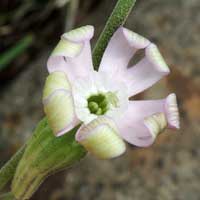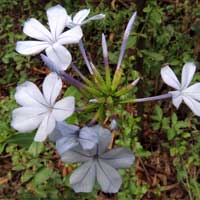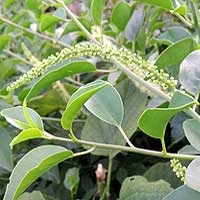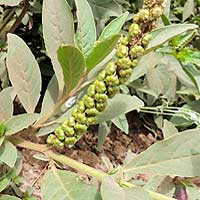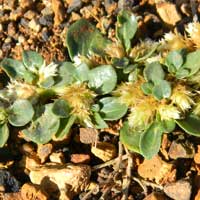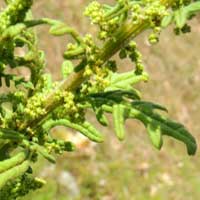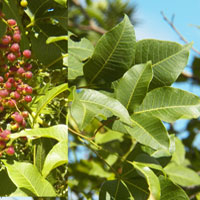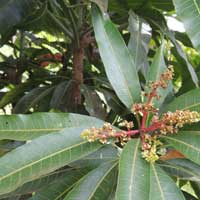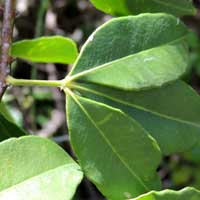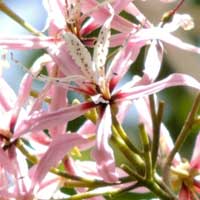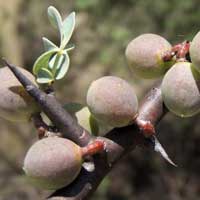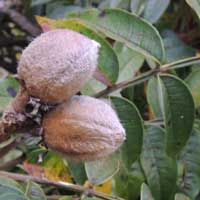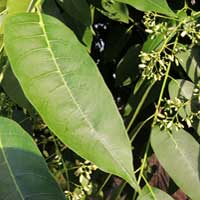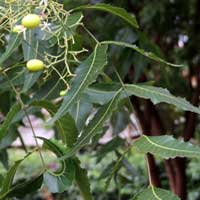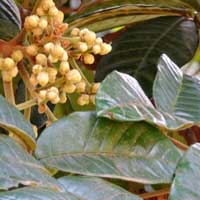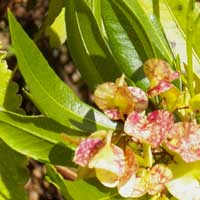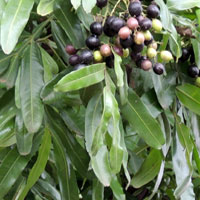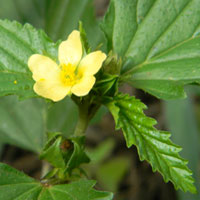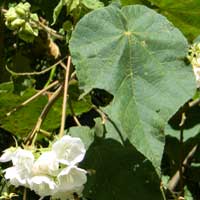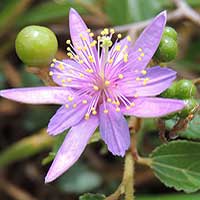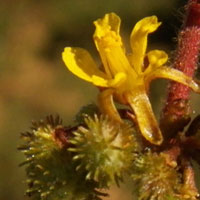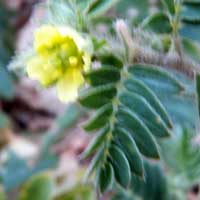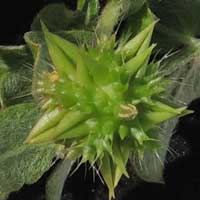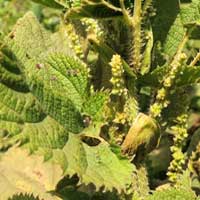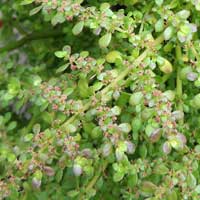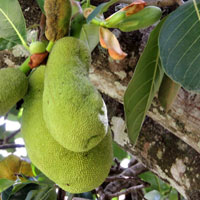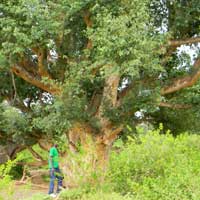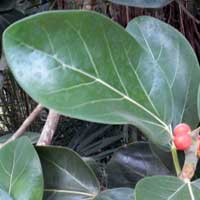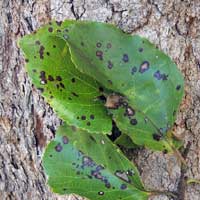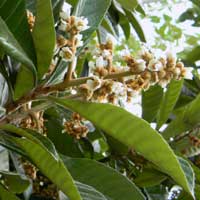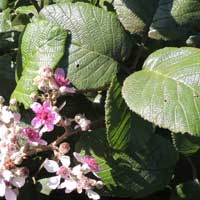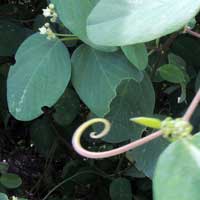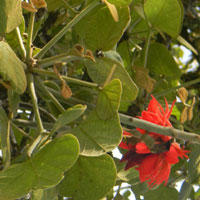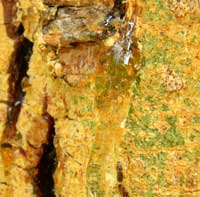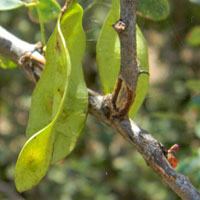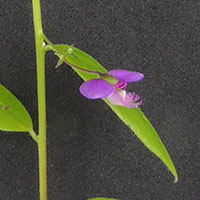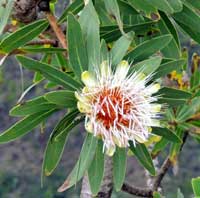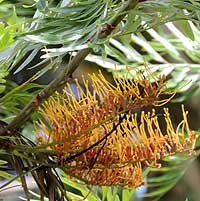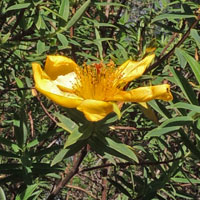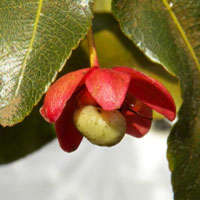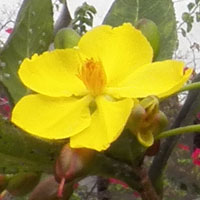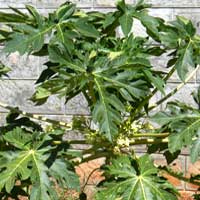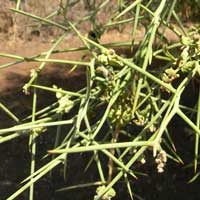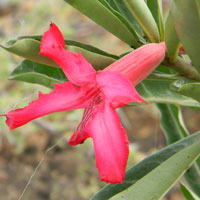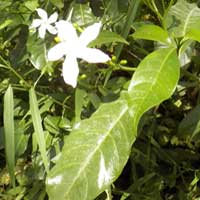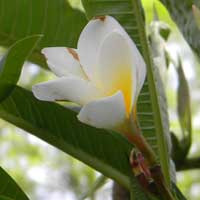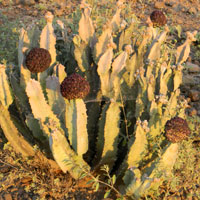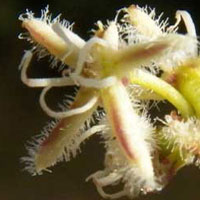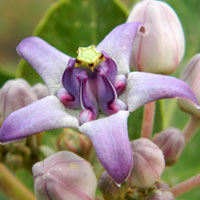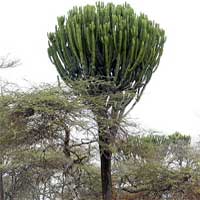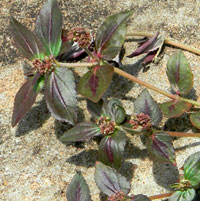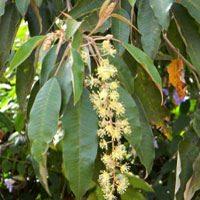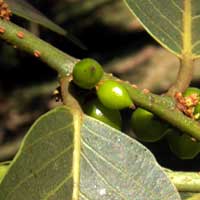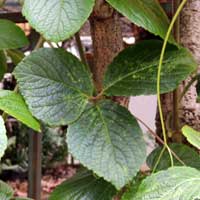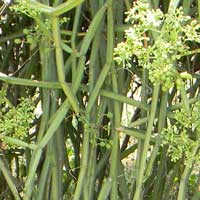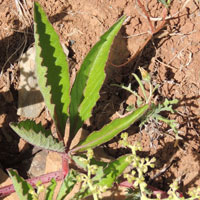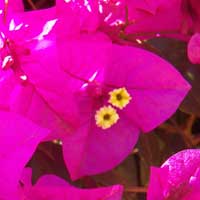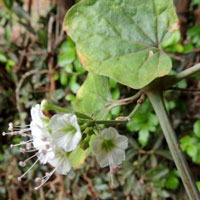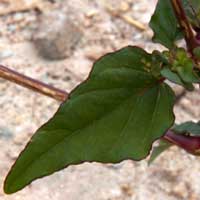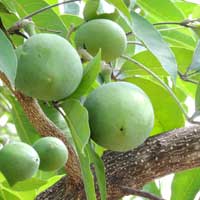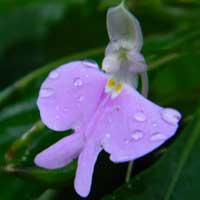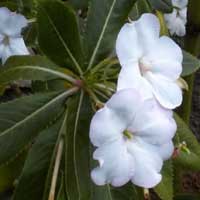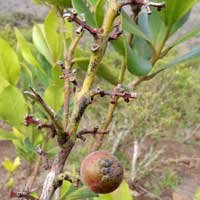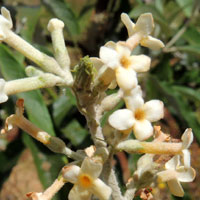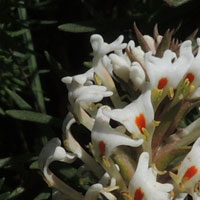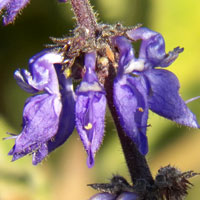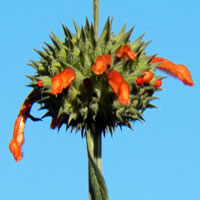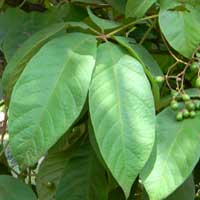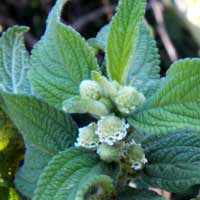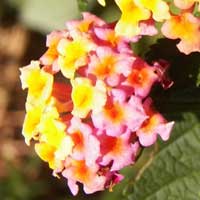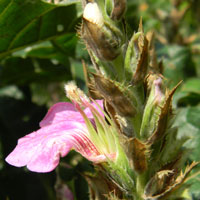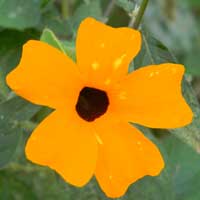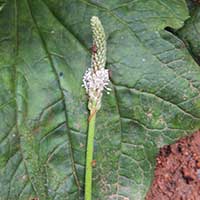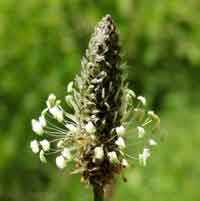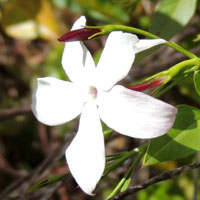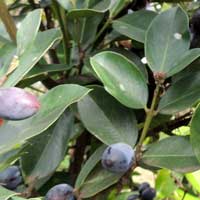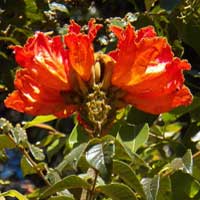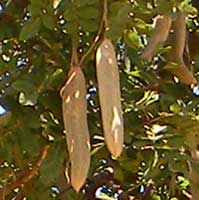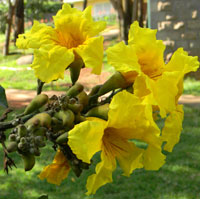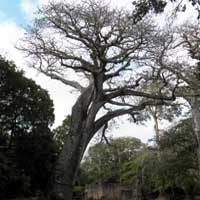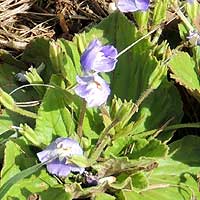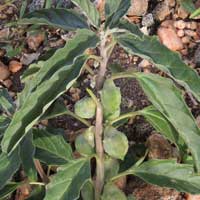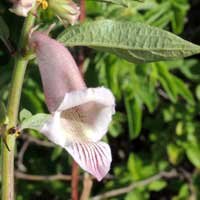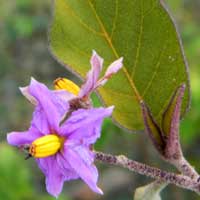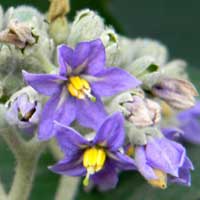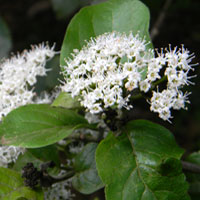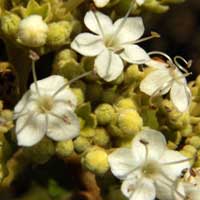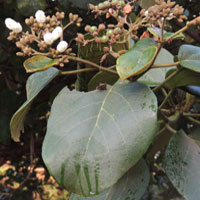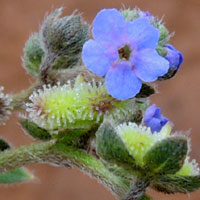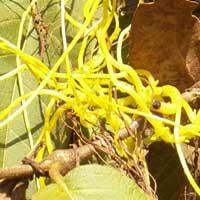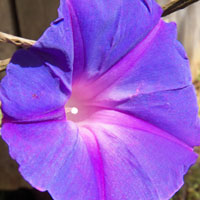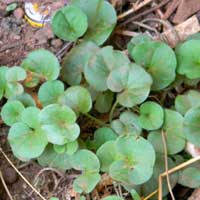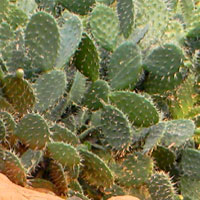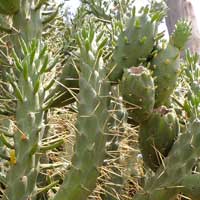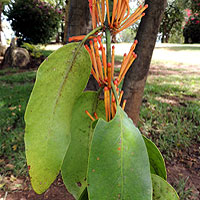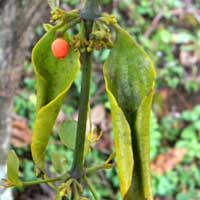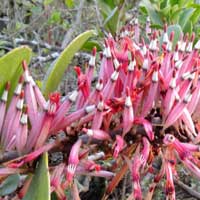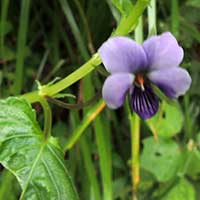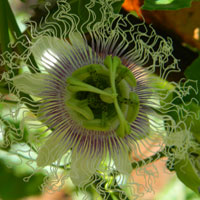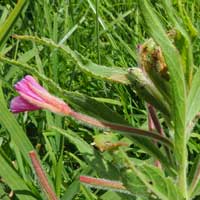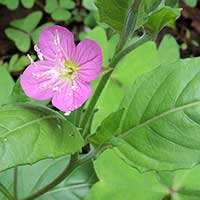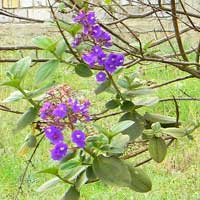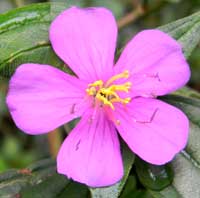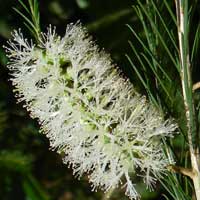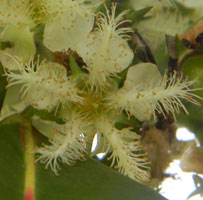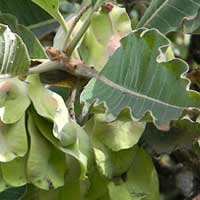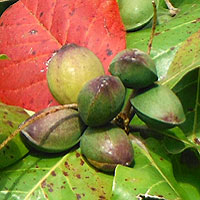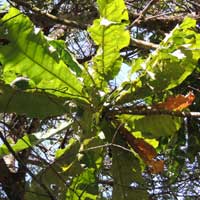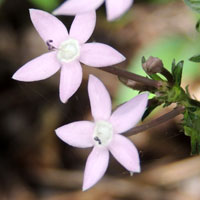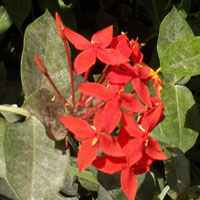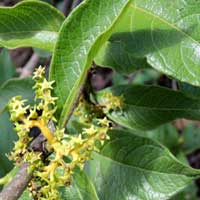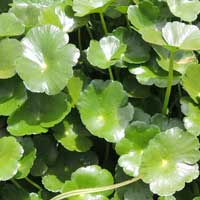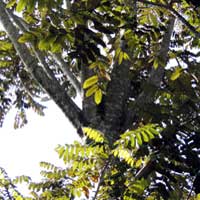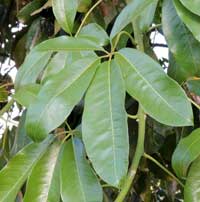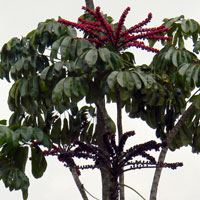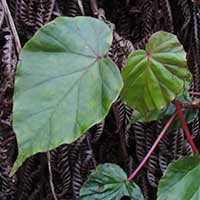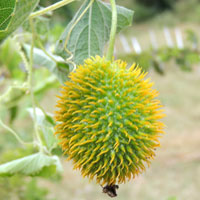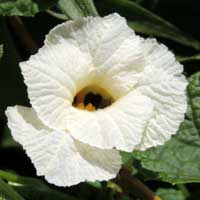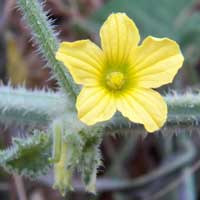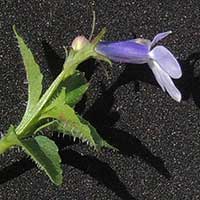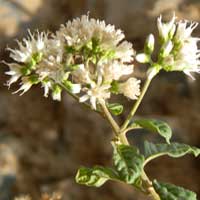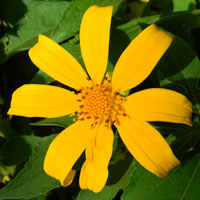Grows closely appressed to moist, damp surface in partial to full shade.
Many moss species in Kenya. Found in moist habitats and rarely taller than a few cm's.
Tufted fern. No flowers or fruit. The fronds are roughly triangular in outline.
Minute floating ferns resembling duckweeds. Color can range from red to green.
Widely cultivated but also native species. Grows upon trees or from breaks in cliff faces.
Thickish narrow leaves. Seeds within a spherical, fleshy cone. Large forest tree in moist highland areas.
Short, scale-leaf needles and cones with a fleshy, aromatic aril. Forest tree with dark gray, scaly bark found at higher elevations.
Plantation timber tree of mid to highland areas. Spherical cones harden and split into a half dozen woody scales. Fast growing.
Dense globe of orange-red flowers make this amarylid conspicuous and widely known.
Spectacular amarillid flowers white, tinged with wine-color opening at night. Margins of rubbery leaves appear crinkled.
Spectacular lily with long red-orange petals and leaves ending in tendril-like appendages.
Rosete of basal grass-like leaves with 6-pointed yellow flowers rising above. Several similar species in Kenya.
Needle-like leaves in clusters along stems. Spikes of small six-pointed flowers. Semi-arid shrub.
Tough, woody stems with numerous side stems reaching lengths of 2 to 3 m and bearing feathery leaves and very stout thorns.
Grass-like leaves are thick and succulent. Yellow flowers in spikes. Native to South Africa, but widely cultivated.
One to several meters tall/long stems in forest understory. Terminal clusters of white or wine-colored flowers.
Clump-forming palm with long, pinnate leaves. Multiple stems may reach 15 m in height.
Agave species are native to Tropical America. A number of species including sisal have been introduced.
Succulent with thick, fleshy leaves. Leaves are distinctly toothed along margins. Tubular, red flowers. Many similar species in Kenya.
Acaulescent aloe - i.e. leaves clustered at ground level. Light spotting on leaves. Highland area devoted to animal grazing.
Grows epiphytically upon branches of trees. Large flowers have red-brown spots on golden yellow.
Large sepals marked with red. Terestial - grows on rocky ground at margins of woodlands.
Flowers and fruit in large, spherical bunches. Leaves long and strap-like resembling palm leaves. Leaf margins sharply serrated.
Floating plant with thick, bouyant leaves. Reproduction often by vegetative budding.
Woody vine with short, sharp thorns and flowers in long, loose spikes. Heart shaped leaves are tough.
Robust reed of river- and lake-side marshes. Characteristic umbrella-shaped inflorescence.
Grass-like plant in usu. moist or wet areas. Branched, terminal spikes of green flowers. Many species.
Bright cream colored inflorescence set this sedge apart. Often grows a meter or more tall. This specimen was growing low in turf.
These plants of moist to wet soil look like grass. Stems are round in cross-section.
Clump-forming grass with stems up to 0.5m tall. Pendulous spikelets crowded at top of infloresence. Often shaded a pink-red color.
... More Grasses!Submerged aquatic herb with numerous very finely divided leaves. Pockets of air inside the long stems serve as floats.
Aquatic plant with floating stems and leaves. Flowers are borne in spikes and have four parts.
Floating plant with inflated stems and spikes of large blue flowers. Exotic invasive sometimes clogs waterways.
Robust herbaceous plant of wet places forming densely packed stands. Cottony seeds in thick-packed spikes.
Long pinnately compound leaves on medium to large tree. Mostly found only in cultivation.
Tree-size, herbaceous plant with the huge leaves oriented in a vertical plane. Complex flower with large showy spathe. Non-native.
Vine-like, herbaceous or slightly woody plant clambers over other vegetation. Two petals much larger than the third. Partly shady undergrowth.
Two large blue petals and one smaller appear for a short time, maybe a day. Common herb or weed in moist gardens.
A slender tree when grown in dense groves with feathery, gray-green foliage and non-showy flowers in catkins. Coastal Kenya.
Frequently planted tree in the mid elevations. Appears pine-like with small cone-like fruit.
Shrubby plant with very large soft leaves with heart-shaped base. Flowers white, minute and packed into dense spikes.
More
Information ...
Also see Cape Wild Pepper
Cultivated fruit tree native to the Amrican tropics. Large, pear-shaped fruit has a scalloped surface texture and custard-like flesh.
Small tree with spherical yellow flowers. Fleshy fruits in clusters. Leaves eliptic and smooth-margined. Among many native Annonaceae.
Small to large tree with rounded crown and shiny green, simple leaves. Fruit a spherical berry.
Large fleshy fruit with a single large seed at center. Leaves elyptic, smooth margined and dark green. Origin is also tropical America.
Familiar floating plants. Large showy flowers with numerous petals, stamens and pistils. Prefers shallow water where roots are anchored in bottom soil.
Floating water plant with big leaves and white, five petal flowers.
In moist soil, often in partial shade, this herb has distinctive compound leaves.
White flowers about 2cm in dia. from a vine growing in sunny locations.
Herbaceous plants of moist soil in the mountains. Five petals and numerous stamens and pistils.
Delicate plant resembles a Lilliputian umbrella that folds up when disturbed!
Herb with usually no above-ground branching. Leaves divided into 3 equal parts - trifoliate. Flowers singular.
Conspicuous when flowering. Leaves ovate, simple, lightly serrated and often notched at tip. Straight, long thorns.
Woody plants with long, pendulous branches, opposite leaves and small clusters of whitish flowers.
Woody shrub with stout thorns. Spherical fruits turn orange when ripe. Oblong, alternate leaves.
Alternate, shiny leaves with serrated margins and a sturdy thorns arising from leaf axils. Large, leafy shrub. 1 cm fruit ripen to orange.
Bright yellow flowers with five petals on very prickly herbaceous plant. Followed by a spiny pod. Non-Native.
Small tree with alternate, elliptical leaves and woody fruits arranged into s spherical cluster. Flowers cream- colored.
Bright yellow flowers on a creeping, succulent herb. Leaves obovate. Weed of gardens, but also a vegetable.
Forms mats of succulent, leafy stems and yellow flowers with four petals. Widely distributed in tropical Asia and Africa. Leaves opposite.
Succulent leaves are in a rosette at ground level. Four yellow petals. Clusters of flowers on a tall flower stalk almost a meter tall. Keyed to K. prittwitzii.
Dense clusters of orange-pink flowers at apex of succulent plant. Large, leathery and thick leaves with scalloped margins.
Leaves nearly orbicular with the stem attached at center. Twining vine from woody base. Small whitish flowers.
Herbaceous vine with round or slightly rhombic, velvety leaves. Flowers small, green in long, pendulous spikes.
Small tree or shrub with thick lance-shaped leaves. Flowers in spherical clusters followed by berry-like fruit.
Scrambling seaside shrub with long whitish stamens and white petals. Leaves thick and nearly round.
Widely cultivated variety of kale - an open-leaf variety of cabbage.
An herbaceous garden weed in relatively cool highland areas. Fruit appear as small, discs with a small notch at apex.
This is a shrubby version of the familiar sheep sorrel. Small pink flowers give rise to showy fruit with pink wings.
Twining plant with heart-shaped leaves and small green-white flowers.
Spikes of pink to white flowers on mostly herbaceous plant of wet or submerged soil. Leaves lance-shaped.
Weedy annual or perennial. Leaves opposite at swollen stem nodes. Five pale petals.
Slender herb with grass-like leaves and with pale lavender blooms. Leaves opposite.
Scrambling plant growing almost vine-like up and over other plants. Pale blue flowers with very long tubes in clumps.
Scrambling plant reaching several meters and sometimes vine-like. White flowers followed by blue-black berries in spikes. Leaves elyptic.
Spikes of white flowers ripen into purple berries on leafy, shrubby plant. Leaves pubescent.
Tan, scaley-looking flowers on small plant that grows flat against soil. Broadly elyptic leaves are dark green.
An erect herb that may become thick and woody near ground. Very small, mealy, green flowers in clusters. Foliage strongly scented.
Trifoliate leaves shiny and with leaflets tapering to point. Clusters of kidney-shaped berries.
Widely cultivated fruit tree. Dark green, shiny, simple leaves on large tree. Panicles of many small cream flowers.
Woody vine with aromatic, trifoliate leaves and sharp, curved spines along the branches. Small, whitish flowers.
Tree with dark green, aromatic, alternate leaves, sprays of large lavender flowers and a fruit resembling a bumpy chestnut.
Resinous tree with exfoliating bark and gray-green trifoliate leaves. Short, stout thorns also and resinous berries.
Tree with long, shiny green,even-compound leaves. Red seeds in spherical capsule. Flowers in spikes.
Large tree with brown bark and v. long compound leaves. Small white flowers in clusters. From south Asia.
Exotic tree for shade and timber. Long pinnate leaves. Small white flowers.
Tree. Panicles of fragrant cream flowers. Large compound leaves alternate and with rusty pubescence below.
Evergreen shrub with slightly resinous Elliptical leaves. Fruit a union of three, colorful papery wings. Flowers small, green.
Tree. Compound leaves with broad wing on rachis. Small white flowers followed by blue-black berries.
Largely herbaceous plant with yellow or yellow-orange flowers. Five petals and numerous stamens with filaments fuzed into a column.
Large, heart-shaped leaves help id this shrub or small tree. White or pink tinged five-petaled flowers in groups with numerous fuzed stamens.
Five pink petals above five longer sepals of a lighter shade. Four-lobed fruit is unique. Small tree/shrub.
Mostly herbaceous plant with small, 5-petalled, yellow flowers and fruit a small sphere with hooked projections.
Also called puncture vine - its seeds can poke holes in tires. Small yellow flowers and pinnate leaves. Trails along the ground.
Similar to previous, but with more intricate burred fruit. Leaves and flowers also larger.
Robust herbaceous plant with broad, serrated leaves. All foliage is beset with needle-like spines that sting!
Mat-forming herb with rather succulent stems. Very small flowers with papery scales. Introduced.
Large tree with big shiny leaves and very large fruits covered with pyramidal bumps. Cultivated in warm, humid areas.
Medium to large tree with big, smooth green leaves and thick heavy limbs. Clusters of 4cm dia. fruit are borne in clusters on short branchlets arising from main branches.
Aerial roots become additional trunks to support a huge spreading tree. Large, glossy leaves.
Alternate simple leaves with serrated margins. Medium to large tree with rough bark.
Medium sized trees with dark green Elliptical leaves grown mostly in gardens for their fruit. Cream-color flowers in panicles. Native to subtropical southeastern China.
Scrambling shrub with sharp prickles on the stems, panicles of pink-hued flowers, folllowed by orange berries. Highland forest edges.
Slender vine with coiled tendrils and ovate leaves. Small white flowers in clusters.
Small or medium sized tree with clumps of bright red tubular flowers, coral-colored beans and trifoliate leaves. Short curved thorns.
Bright yellow, bilaterally symetrical flowers have a maroon center. Woody shrub or small tree. Two-lobed leaves are distinctive.
Tall savanna trees with distinctive yellow, green and brown bark. Leaves twice-compound. White thorns in pairs. Lots of resin oozes from injuries.
Relatively few, large leaflets in double-compound leaves. Beans in flat, twisted pods. Short hooked spines. Usu. a shrub or rarely a small tree.
Slender herb, mostly obscure but with very curiously shaped flowers. Sunny forest edges. Several species of milkwort found in Kenya.
Small sparsely branched tree with elliptical leaves and large flowers with numerous petals.
Feathery, pinnately divided leaves on large forest tree. Bark is dark and fissured. Australian import.
High mountain habitats. Dark green leaves are simple and crowded on ends of branches of stiff-branched shrub. Yellow flowers with many stamens.
Leathery elliptical leaves with serrated margins on medium-sized tree. Sepals yellow turning red after yellow petals fall. Fruit turns black when ripe.
Name refers to the bright red fleshy sepals and black fruit. Five bright yellow petals. Leaves sharply serrate.
Small fruit tree with one main stem, large palmately lobed leaves, and with groups of axillary flowers and large, ovoid fruits.
Dark green leaves born on branches with many elongate green throns. Solitary flowers and fruits dispersed along the stems.
Stems are thick and succulent and the base may be swollen. Dark green leaves and bright pink flower.
Evergreen shrub with dark green opposite leaves and milky sap. Fragrant, white, pinwheel-like flowers with 5 petals.
This showy dogbane has been redistributed to tropical gardens around the world from it's American origins.
This milkweed has the appearance of a cactus. One meter tall near Lake Baringo.
Vine with pairs of very long, slender pods. Seed with long silky hairs. Milky sap from breaks.
Large robust milkweed with big thick leaves and purple star-shaped flowers. Large globular seed pods.
Tree-sized succulent, with smooth, angled, columnar branches. Small green or reddish flowers. Milky sap from cuts. Savannas.
Many kinds of very small spurges grow close to the ground and mostly go unnoticed. Minute flowers in dense heads.
Matures to a large forest tree. Large leaves are green on top and silvery beneath. Flowers in long, pendulous spikes.
A shade tree with large elyptic leaves, small yellowish flowers and elypsoid fruits that ripen to black and are sweet.
Vine with toothed, trifoliate leaves and tendrals from stem nodes. Berries about 1cm.
A succulent member of grape family with green, photosynthetic stems. Draping over a woody shrub.
Dark green, palmately compound leaves on vine like plant in open rangeland. Reddish glands on stems and inflorescence.
Non-native. Rank vine forming a shrub on fences or covering another plant sometime in excess of 3 m. Sharp thorns on branches. Brightly colored bracts subtend cream flowers.
Long slender stems scramble up and through other plants. Clusters of white funnel-shaped flowers. Club-shaped fruits.
Flowers are very small, but can be bright pink or carmine. Triangular leaves with reddish, wavy margin. Stems swollen at nodes.
Large simple leaves on medium to large tree bearing round fruit with yellow, custard-like flesh. Non-native. Cultivated.
Bilaterally symetric flower with a long curved nectary spur. elliptical, sharply serrate leaves. Kakamega Forest.
This impatiens has all white flowers and lance-shaped, serrated leaves. Might be non-native in cultivation only.
Shrub with evergreen leaves and spherical fruits. Leaf margins wavy.
Two to three m tall shrub with many stems and spikes of four-parted, small cream flowers.
Evergreen shrub of montane habitats and edges of elfin forest. Spikes of white flowers.
Robust shrubby plant with opposite, deltoid leaves with rounded teeth and ringed clusters of deep purple, two-lipped flowers.
Bright orange tubular flowers emerging from spiny balls of closely packed flowers and seed capsules.
Forest tree with medium-sized, five-parted, palmately compound leaves. Small flowers and berries in flat-topped panicles.
Small bluish-white flowers in short, crowded spikes. Leaves with prominent veins and aromatic oils.
Spherical clusters of orange, red, pink and yellow tubular flowers on fast growing shrub. Aromatic.
Spikes of lavender-pink flowers above large, spiney-edged leaves. Kakamega Forest.
Unmistakeable flower on a vine that grows in gardens and in sunny borders.
Small pale flowers are set in a slender spike. Herbaceous plant with leaves all basal.
The leaves are grass like, but wider. Flowers, small, in conical cluster upon tall slender spikes.
Scrambling vine with opposite, compound leaves and fragrant, white flowers with long tubes and five lobes.
Medium to large dark green tree. Smooth margined, opposite leaves without stipules. Purple drupes with one hard seed.
Stately tree with dark green, compound leaves and large clusters of big, orange-red flowers.
Long and heavy fruits hang from the branches like so many sausages set to age. Remarkable flowers also that release scent at night.
Small to medium sized tree with dark green compound leaves and showy, bell-shaped flowers.
Distinctive, huge tree of hot, seasonally dry habitats through much of tropical Africa. Thick, massive trunk appears oversized.
After rains these violet-like plants immediately spring up with blue flowers. Broad, ribbed leaves in basal rosette.
Uncommon plant. Opposite leaves on a low, mostly herbaceous plant.
Upright, mostly herbaceous stems topped with large lavender, two-lipped blossums.
Very common mostly herbaceous plant at roadsides. Fuzzy leaves, spiney stems, purple flowers and yellow fruits.
Two meter tall shrub or small tree with flat-topped panicles of purple nightshade flowers. Kakmega Forest.
Large shrub or many-branched tree with sprays of small white flowers. Twigs with whitish hairs becoming groups of orange berries. Relatively large elyptic leaves.
White actinomorphic flowers in headlike clusters. Leaves broadly elyptic and leathery. Fruit berry-like but turning hard.
Large ovate leaves, stiff textured and with coarse hairs on veins and stems. Petals 5, white, fragrant flowers. Berries orange when ripe.
Coarse, herbaceous, with blue flowers about a meter tall. Seeds inside clinging burs.
Bright orange climbing stems without chlorophyl and without leaves. Small white flowers in clusters. Parasitic.
Large, showy tubular-funnel-form flowers on herbaceous vines. Often cultivated on fences.
Prostrate herb with distinctly heart-shaped leaves. Flowers obscure. Often used as ground cover.
Stems jointed and laterally compressed into round or obong pads. Flowers mostly yellow and with many petals and stamens.
Popular fence row plant in semi-arid areas. Native to the Americas. Many sharp spines plus minute hair-like spines.
Hemiparasite in trees. Leaves elyptic and dark green on pendulent braches. Orange-red flowers in clusters. This one in green ash.
Pendulous, parasitic shrub found growing directly out of branches/twigs of a host tree. Groups of reddish or white berries and with leathery leaves.
Beautiful sprays of pink flowers make this one of the showiest of mistletoes!
Low-growing herbaceous plant of moist woodlands and forest edge in mountains.
Climbing vine with spectacular, unique flowers. Leaves with two or three lobes and stems bare tendrils for climbing. Widely cultivated for the purple fruit.
Wetland plant with soft, hirsute leaves and pink-magenta flowers with four petals.
Non-native, mostly herbaceous plant with 4-petaled flowers and inferior ovary. Eight stamens and four part stigma.
Showy, non-native shrub. Leaves with conspicuous parallel veins. Hooked stamens.
Leaves with conspicuous parallel veins and flower with inferior ovary. Kakamega Forest.
Non-native forest and ornamental tree widely planted in Kenyan. Almost linear leaves and spikes of snowy-white flowers.
Exotic tree from Austalia with white flowers and gum-tree like fruit. Large elyptic leaves with smooth margins.
Large elyptic leaves clustered near branch ends. Fruit with papery wings.
Substantial shade tree found in areas near the beach. The elliptical fruits can float. Large oblong leaves turn red before falling.
Understory forest tree with tall slender stems and very large, spatulate leaves clustered at ends of branches.
Now widespread around world as an ornamental. Kenya native herb with five-parted, long tubular flowers. Color is white, pink or red.
Understory shrub with opposite, dark green, elliptical leaves. Four petals on a long tube. Common, introduced ornamental.
Large, multistemmed shrub with opposite, dark green, simple, entire leaves. Fruit is spherical and orange-red.
Floating plant of marshes and pond edges. Circular leaves are attached at their center and margins wavy.
Tall tree with straight bole. At a considerable height a set of 8 or more radial branches. Pinnate leaves close to a meter long.
Tree with palmately compound leaves with long petioles and long petiolules. Small, cream-white flowers in umellules and spikes.
Tall tree sparsely branched with very large palmately compound leaves. Red flowers arrayed in many radiating spikes a meter long.
Begonias are readily recognized by their unique leaf shape. But many species make id beyond that more challenging.
Cucumbers covered with fleshy spikes and releasing unpleasant odor when cut. Herbaceous vine with tendrils.
Cucumbers covered with fleshy spikes. Herbaceous vine with tendrils. Rather large blooms with pleated/crinkled texture.
Herbaceous vine with simple tendrils, bright yellow flowers and fruit covered with long, stiff bristles.
Besides the giant Lobelias of the high mountains, there are many smaller wildflower species.
Large shrub to tree-sized member of sunflower family. Flowers white, in bi clusters of ray-less heads. Leaves elyptic and leathery.
Large yellow-orange composite, but smaller than seed sunflower. Leaves variously three-lobed. Mostly herbaceous up to two meters tall. Garden favorite.
More Composites/Asteraceae